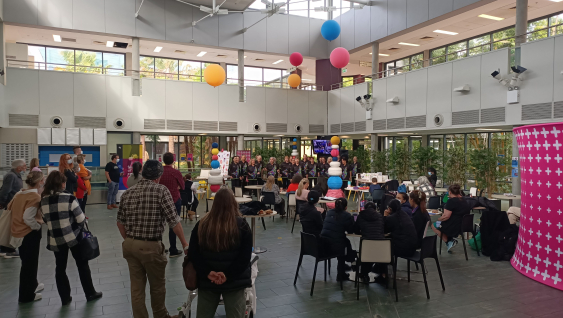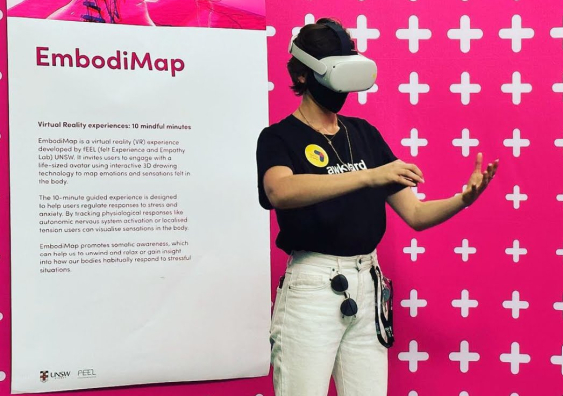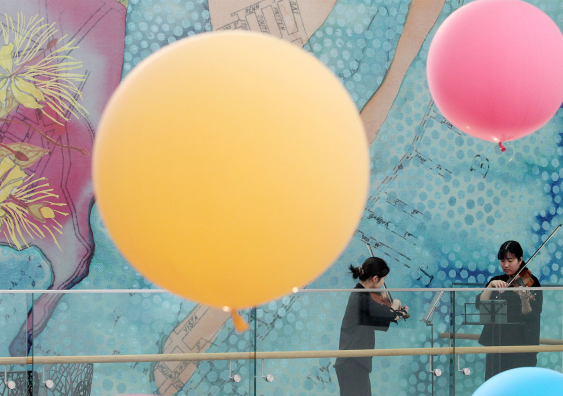University of New South Wales Sydney Supports Sydney’s Hospital Workers with the Festival of Care
A new festival is prioritising the wellbeing of healthcare workers in hospitals in Sydney’s Southeast. The Festival of Care is bringing creative arts-based interventions to the Sydney and Sydney Eye Hospital (12-14 September) and Randwick Campus (Prince of Wales Hospital, Mental Health Services and Royal Hospital for Women, 15-22 September) to help staff reduce stress and to recognise their contribution and dedication.
The festival, previously held at St George and Sutherland Hospitals, provides a ‘taster’ of experiential tools to help frontline health workers manage anxiety, trauma and burnout in the wake of COVID-19, says project co-lead Scientia Professor Jill Bennett, Director of the Big Anxiety Research Centre (BARC) at UNSW.
“Arts-based recovery or wellbeing therapies are often used for patient care; the Festival of Care explores ways to introduce and embed arts-based care within hospitals to enhance the psychosocial wellbeing of staff,” says the Australian Research Council Laureate Fellow.
The program includes welcome events, ‘awkward conversations’, artists in residence, ambient live music, virtual reality (VR) for wellbeing, interactive musical experiences and hands-on workshops. “It looks at ways to start conversations as well as provide connections to further support through an experience that is stimulating and enjoyable and inherently relaxing,” she says.
A research-driven initiative
The Festival of Care is a UNSW ADA Innovation Hub project in partnership with BARC and the South Eastern Sydney Local Health District (SESLHD). The Innovation Hub is a project-based collaborative problem-solving initiative led by UNSW design academic Dr Carly Vickers.
The festival is an example of how the Innovation Hub partners with government and industry to promote positive change, and provides ADA’s researchers, centres and institutes with new opportunities to build on their research impact.
“The festival is evidence-driven, co-designed by UNSW designers, researchers and creative practitioners with SESLHD leaders and Wellbeing Ambassadors,” says project co-lead Professor Michael Balfour, an expert in applied theatre and performance work within social contexts.
“Connecting with government and industry, through the Innovation Hub, has created fertile interdisciplinary exchanges that both ground the research and deliver real-world change.”

The Festival of Care creates spaces within the hospital environment that offer light-touch engagements from brightly coloured totems to music, art and virtual reality experiences. Photo: Supplied.
Seizing the moment
The festival encourages staff to ‘pause and engage’ within their busy healthcare environments. “People are there to work. They might have five or ten minutes, they might be on their way somewhere, they might already be stressed, so the focus is on immediate, accessible and fun activities that provoke curiosity,” Prof. Bennett says.
“There are curated ambient interventions that permeate the space and transform the environment, and light-touch engagements, and opportunities for interaction that people can return to later for a deeper engagement.”
The high-pressure environments of hospitals mean having opportunities to share experiences is important, she says. “Our awkward conversations program allows people to have 15-minute one-to-one conversations with our team of trained listeners. It makes conversation accessible without people having to contend with the barriers associated with seeking help.”
These awkward conversationalists come from art, psychology and counselling backgrounds, making them adept at managing authentic discussions of hard-to-tackle issues, such as depression, work-place stress and complex life issues, she says.
Transforming spaces
The hospital environment is transformed through a series of sculptures, or totems, designed by UNSW design academic Katherine Bond and fabricated within ADA’s Design Futures Lab using recycled plastics, including expired hospital scrubs, in line with circular design principles.
“The totems contribute vibrant colour and textural complexity to create an uplifting atmosphere within the healthcare environment. Their subtle manipulation of space promotes new experiences and invites engagement with the festival’s program content,” says Ms Bond, the festival’s lead spatial and experience designer.
Hospital staff can also access Embodimap, a ten-minute experiential VR program designed by Prof. Bennett’s team that allows users to explore and map their feelings through their body. The program is used extensively in support contexts, such as schools, refugee programs and patient care, to alleviate stress, anxiety and trauma. Its inclusion in the festival reminds us of the need to care for our carers and ourselves, she says.
“Health professionals, perhaps more than most people, often neglect their own health and wellbeing in the process of focusing on others in their professional roles,” she says. “So providing an outlet [for them to explore their thoughts and emotions] can be really important.”

Embodimap is a ten-minute experiential VR program that allows users to explore and map their feelings through their body. “Its inclusion in the festival reminds us of the need to care for our carers and ourselves,” says Prof. Bennett. Photo: Supplied.
Getting creative about wellbeing
Engaging with art and creativity allows us to reflect on feelings of stress, distress and emotional dysregulation; it creates mindful opportunities that can refocus and relax people, says Prof. Bennett. “Then, on top of that, we have these very specific tools which go deeper, which are informed by therapeutic practice,” she says.
“But they still operate in this vein of creative enquiry, really enabling people to understand processes that are hard to talk about and conceptualise, let alone shift.”
The collaborative dimension of the program is significant; “often coming out of yourself and finding a connection with other people is really important,” she says. For example, in ‘Make your Mark’, designed and facilitated by UNSW design academic Chloe Cassidy, staff are invited to ‘make a mark’ or an individual artwork; these artworks are then digitally combined to create a collective mural for installation within each hospital.
“Simple acts of self-agency, such as creating art, can help people reach a state of active calm that helps with self-regulation and healing from trauma,” says Ms Cassidy who specialises in practice-based interventions for trauma-informed care.
Making space for difficult conversations
The festival also revives an in-depth theatre project on mental health and suicide, Grace Under Pressure, codesigned with junior doctors and nursing staff at the inaugural Big Anxiety Festival in 2017. “At the Festival of Care, it provides a framework for having difficult conversations about mental health, toxic workplaces and other related issues within a workshop environment,” says Prof. Bennett.
The festival opens up the potential for ongoing projects for psychosocial wellbeing within hospitals in line with BARC’s more sustained work transforming the impacts of trauma on communities. The centre places lived experience at the core of its research, creative practice and design through projects, such as The Big Anxiety Festival and The Big Reach.
It aligns with the commitment of SESLHD to enhance the health and wellbeing of staff. “As we emerge from the COVID-19 pandemic, our staff in healthcare facilities continue to experience workplace pressure and stress,” says Chief Executive Tobi Wilson from SESLHD. “The Festival of Care enables our people to find creative ways to support their wellbeing at work.”
The Festival of Care project and the ADA Innovation Hub more broadly align with the UNSW ADA2051 strategy to leverage faculty knowledge and skills to create a future that is sustainable, connected, healthy and socially just for all.
“The Festival of Care stands testament to the rich contribution that collaborations across education, research and healthcare organisations can make to the broader community,” says Professor Claire Annesley, Dean of UNSW Arts, Design & Architecture.
“Working in concert with NSW Health and NSW Government, we’re promoting transformative, research-driven change to support positive health outcomes and more sustainable wellbeing.”

